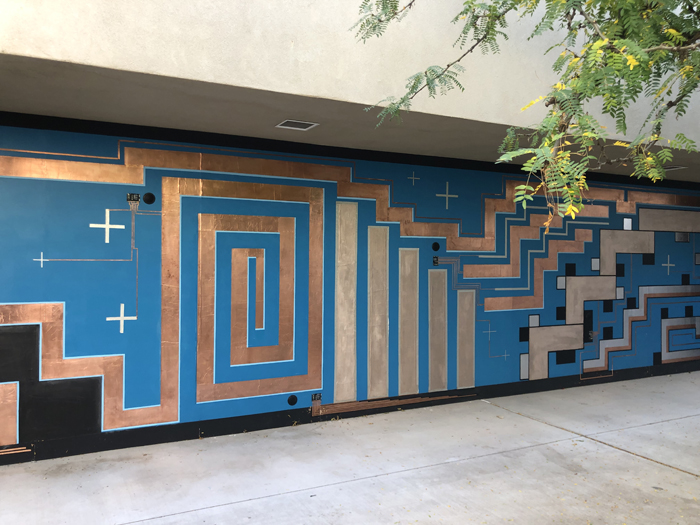Nani Chacon, Hand and Machine, and Working Classroom student artists collaborated to create PAHTIA, an interactive, site-specific space for healing via art and technology at Albuquerque’s National Hispanic Cultural Center.

ALBUQUERQUE—When the beholder approaches the interactive, collaborative mural PAHTIA at the National Hispanic Cultural Center in Albuquerque, it welcomes you with the visual complexity that murals are known for as well as tactile feedback and sonic resonance that can be felt in the body. Existing in dialogue with the Meso-American architectural elements referenced by architect Sofia Marquez in the Hispanic Cultural Center’s overarching design, site-specific mural PAHTIA greets visitors to the Visual Art Museum’s courtyard with shifting soundscapes.
PAHTIA is the third public art project produced through a collaborative, grant-funded partnership led by artist Nani Chacon (Diné) and the Hand and Machine research group within the University of New Mexico’s computer science department. In addition to the group’s pilot mural A/B (2021) in UNM’s Farris Engineering Center, an untitled mural (2022) outside Working Classroom was created by student artists working with the group and depicts the plants and pollinators of their home landscapes using traditional paint, custom hardware, conductive ink, paint, and tape.
Like the untitled Working Classroom mural, PAHTIA was a genuinely collective public art endeavor. Created and conceptualized by student artists from Working Classroom in collaboration with Chacon, artist Mia S. Shaw and Alyshia Bustos, Alyssa Johnson, and Leah Buechley of Hand and Machine, PAHTIA began by asking two questions: “How can we create spaces for community and individual healing?” and “How does the activation of a space contribute to healing?”
Built to act as public amplifiers, ancient Anasazi, Aztec, and Mayan structures resonated with the frequencies of ceremonial chants, music, and prayer. Inspired by Meso-American and pre-colonial design in terms of both aesthetics and function, PAHTIA references ancient healing practices that used sound frequencies to activate healing responses in the mind and body.
For Chacon, these murals continue early creative interests that stretch back to her first public mural, She Taught Us to Weave. Created by Chacon for the Albuquerque Public Art Program’s Wells Park Rail Corridor Project, She Taught Us to Weave (2012) employs the lens of the Navajo creation story of Spider Woman to reexamine tools of sustenance and communication during an era of technological complexity. For that mural, the artist’s sister Autumn Chacon created and embedded a low-power radio transmitter to emit the Navajo phrase “Hozho naahaslii” as a tribute to Hózhó, the intrinsic value of living beautifully.
“The education side of mural integration and community engagement is very interesting to me. I’ve worked with students a lot and have integrated them into my mural work. This project shows them the art side and the fact that technology is a new frontier for artistic exploration,” Chacon says. “It lends students a whole new set of skills and tools to create or communicate with. They also do all these other things and are able to bridge into science and use that set of skills and tools to further dialogue and communication.”
In this public art project, the visual and the technical are deeply intertwined.
“Essentially each mural is a giant, architectural-scale circuit board where the circuits are made from conductive paint, which conducts electricity. So instead of a traditional circuit board made of metal or wires, we paint it. So [the technology] is really integrated into the mural,” says Buechley of Hand and Machine. “In the case of PAHTIA, we were experimenting with a wide range of materials—not only conductive paint but metal foil tapes. So there’s copper, tin, and aluminum. And we’re using those materials both as technical engineering materials and also as the primary visual palette that we have to work with.”
The same sort of deep integration informs the project’s educational goals and practices.
“My research mainly focuses around engaging students in non-traditional ways to learn about [science, technology, engineering, and mathematics, or STEM] concepts,” explains PhD graduate student Bustos. “We do that by leveraging their existing interests. All the students we work with have a lot of history with the art-making process. A lot of them are artists. They’re painters or they sketch. They’ve done other art workshops. We work with them and use the art community they’re already a part of to introduce them to computer science concepts.”
According to Buechley, Bustos, and Chacon, the PAHTIA mural will remain on display at the National Hispanic Cultural Center for the foreseeable future.



